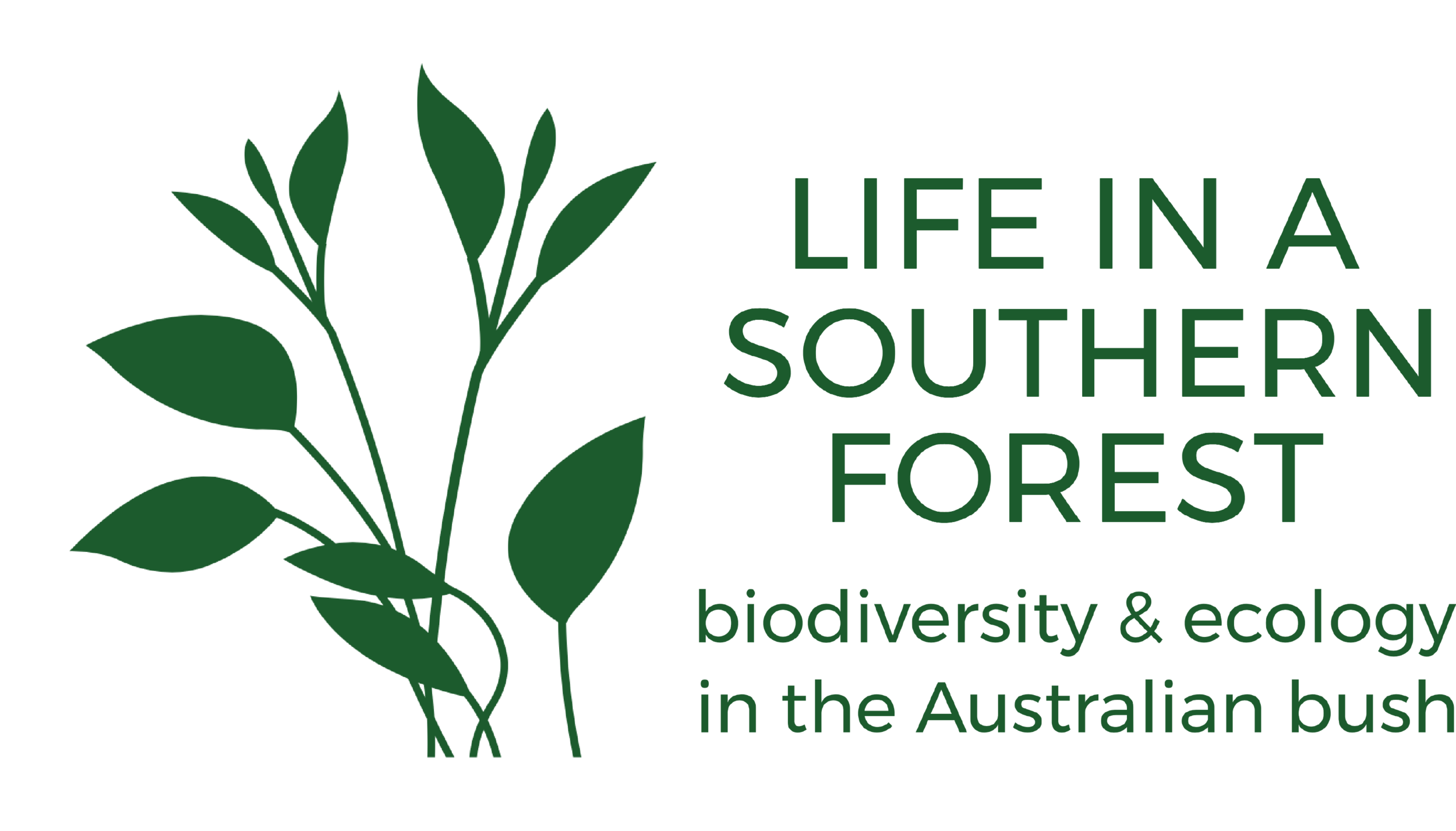
Polistes erythrinus
Ferruginous and black, entirely lacking yellow markings.
Pronotal humeri & keel ferruginous.
Mesoscutum black with ferruginous stripes (this varies; some with much wider stripes; others wholly black).
Wings extensively yellowish brown, including the veins.
Image courtesy Reiner Richter https://inaturalist.ala.org.au/observations/20340579

Polistes erythrinus
Gaster dark ferruginous with black markings, particularly T1, the base of T2, and S2.
Head ferruginous, with black markings including underside and up into the genae.
Image courtesy Reiner Richter https://inaturalist.ala.org.au/observations/21374040

Polistes schach
Almost entirely orange, with just a small amount of black (including: base of gaster; ocellar region) and yellow (including apex of femora, entire tibiae & tarsi).
Image courtesy Reiner Richter https://inaturalist.ala.org.au/observations/25727944

Polistes schach
Head orange, with large black spot encompassing ocelli.
Pronotum orange, with yellow markings largely restricted to keel and hind margin. If there is any yellow on the humeri, it is very limited (as here, just visible in anterodorsal corner).
Image courtesy of Reiner Richter https://inaturalist.ala.org.au/observations/105635057

Polistes tepidus tepidus
Black, with extensive yellow-orange markings, including: head; humeri of pronotum; gaster posteriorly.
Large yellow spots on black mesoscutum are common among northern specimens such as this one from QLD … but they are typically absent of greatly reduced further south.
Legs mostly yellow-orange. Black at base of femora and hind tibia (usually, as here).
Image courtesy of Reiner Richter https://inaturalist.ala.org.au/observations/32633052
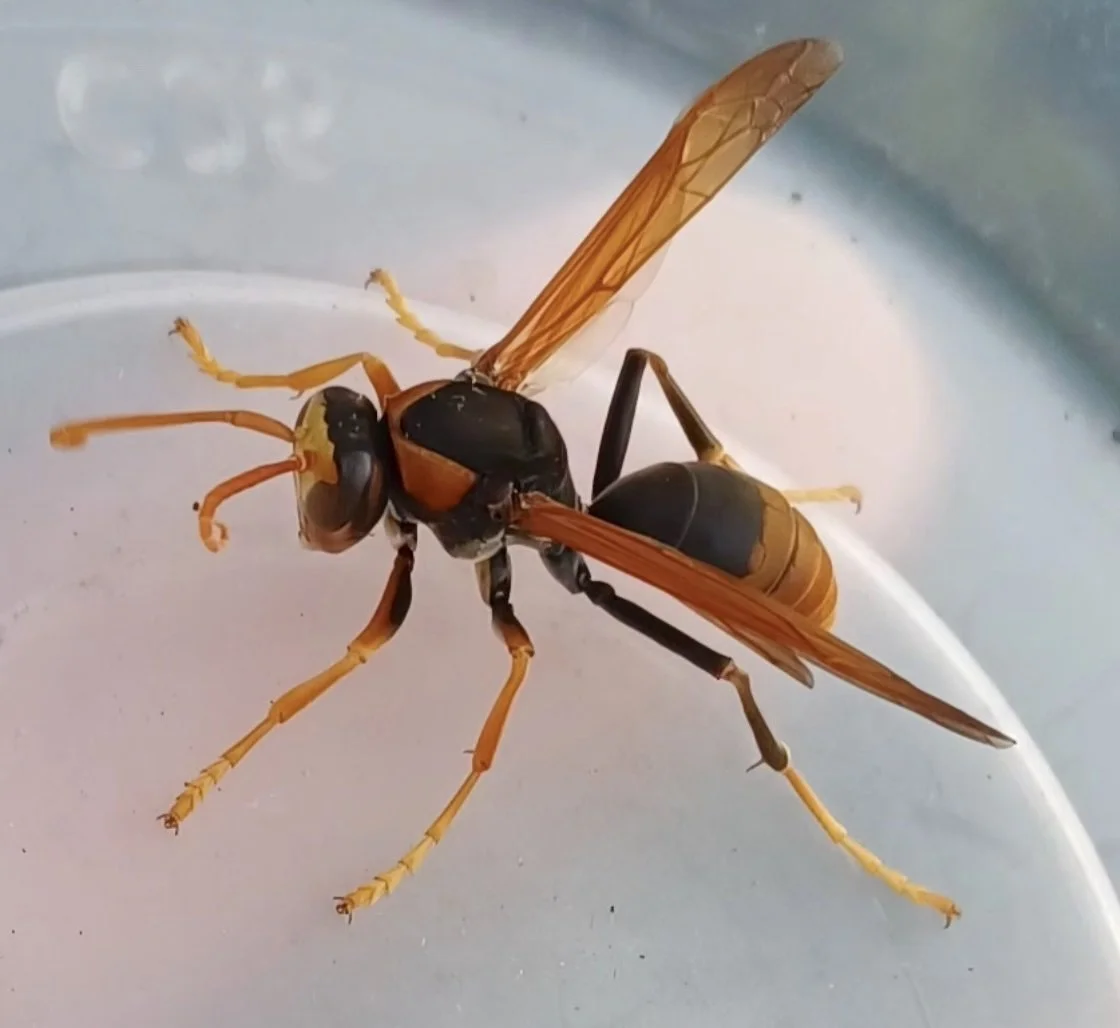
Polistes tepidus tepidus
Black, with extensive yellow-orange markings. The majority of specimens are like this one from NSW, lacking the pair of yellow-orange spots on the mesoscutum that characterise the species in northern QLD and Papua New Guinea.
Image courtesy of Nells Gross
https://inaturalist.ala.org.au/observations/156560134

Polistes tepidus tepidus
Black with orange-yellow markings, including the genae and, in females, a broad yellow band above the antennal sockets. The legs are extensively bright yellow or yellow-orange, but the femora are black, as are the hind tibiae in most southern specimens (like this one from NSW).
Image courtesy of Nells Gross
https://inaturalist.ala.org.au/observations/190482787

Polistes stigma townsvillensis
Clypeus yellow, with black bands dorsally and ventrally.
Head ferruginous, with dark rings around ocelli.
Scutellum ferruginous, narrowly yellow anteriorly (variable).
Metanotum ferruginous, with yellow markings (variable).
Distal half of marginal cell of forewing with a well-defined black spot. Wings otherwise almost hyaline, brownish in costal region. Veins brown.
https://inaturalist.ala.org.au/observations/254086954

Polistes stigma townsvillensis
Ferruginous with highly variable pattern of black and yellow markings.
Pronotum ferruginous, hind margin yellowish.
Mesoscutum ferruginous, with narrow black margin anteriorly (variable, although only very rarely black).
Mesopleruon ferruginous, with some black markings.
Legs ferruginous.
Image courtesy Norm Farmer https://inaturalist.ala.org.au/observations/265035366

Polistes humilis
Black, with extensive ferruginous markings.
T1-3 dark ferruginous, black basally.
Yellow apical bands on T1 and T3 (variable).
Forewings dakrkened apically, but without a clearly defined spot.
Image courtesy of Reiner Richter https://inaturalist.ala.org.au/observations/259415143

Ropalidia impetuosa
Yellow markings include: scutellum; metanotum; apical band on T2, extending around S2.
T1 entirely red-black.
Pronotal humeri (‘shoulder panel’) rust-red (‘ferruginous’), keel yellow.
Image courtesy of Lachlan Copeland https://inaturalist.ala.org.au/observations/271575595

Polistes humilis
Head ferruginous, with black markings on upper frons.
Inner orbits yellow.
Clypeus yellow, with some ferruginous markings dorsally.
Forewings fuscous (brownish grey), with costal region more yellow-brown. Marginal cell darker, but wing without a clearly-defined dark spot.
Legs ferruginous, except coxae and basal region of femora black.
Mesopleuron black.
Image courtesy of observer ‘teenytinyworld’ https://inaturalist.ala.org.au/observations/261964017

Ropalidia impetuosa
General body colour ferruginous (red-brown), but extensively blackened.
Yellow markings strong and obvious, including scutellum, metanotum, stripes on the propodeum, and a broad band on apex of T2.
Image courtesy of sdoug7405
https://inaturalist.ala.org.au/observations/48619802

Ropalidia romandi
Extensively yellow, including: entire pronotum; pleura (sides of thorax); most of the head; last 4 segments of the metasoma (‘abdomen’)
T1 apically (posteriorly) yellow, darker (in this case red) basally.
T2 with a wide, yellow band apically, preceded by a darkened area. Basally red-brown. Yellow spot on spiracle.
Image courtesy of Reiner Richter https://inaturalist.ala.org.au/observations/30729968

Ropalidia romandi
Mesoscutum yellow, with 3 dark (black to rusty brown), longitudinal stripes.
Scutellum yellow, with dark central stripe.
Metanotum yellow.
T1 yellow apically, rusty brown (‘ferruginous’) basally.
Top of head (around the ocelli) black to rusty brown.
Image courtesy of Sandy Clark https://inaturalist.ala.org.au/observations/188633364

Ropalidia socialistica
Pronotum black, with wide yellow stripes laterally, & narrowly yellow centrally.
Mesoscutum entirely black, tegulae yellow.
Scutellum & metanotum each with pair of yellow spots.
Image courtesy of Nadine Gaffney https://inaturalist.ala.org.au/observations/230393502

Ropalidia socialistica
Head black, with yellow spots on upper & lower gena (behind eye); base of mandible.
T2 black, with very wide apical (posterior) band extending forward to the anterior margin & expanding around the spiracle.
T1 black, also with a broad apical band, sides, & spot around the spiracle.
Pleura (sides of thorax) black, with yellow scrobal spot (around stigma of mesopleura).
Image courtesy of Nadine Gaffney https://inaturalist.ala.org.au/observations/259139666

Ropalidia gracilenta
Dark ferruginous overall, with limited and indistinct pale markings.
T1 with white-yellow apical band.
T2 also with narrow apical band.
Image courtesy of Philip Griffin https://inaturalist.ala.org.au/observations/263425056

Ropalidia gracilenta
Overall dark red-brown, with the following pale spots/marks visible dorsally on mesosoma: pronotal keel; tegulae; scutellum; metanotum; propodeum.
Image courtesy of Lachlan Copeland https://inaturalist.ala.org.au/observations/294772228

Ropalidia plebeiana
The ferruginous mesoscutum with black markings, an example of the colour variation seen in this species.
T2 with an apical yellow band … another variable feature of R. plebeiana.
Image courtesy of Reiner Richter https://inaturalist.ala.org.au/observations/269191397

Ropalidia plebeiana
Yellow spot at base of mandible.
Yellow preapical band on T1.
In this individual, T2 is entirely ferruginous and with long, appressed hairs.
Image courtesy of Phil Warburton https://inaturalist.ala.org.au/observations/116811489

Ropalidia plebeiana
In some individuals, the ferruginous areas are extensively blackened.
Unlike females, this male has serrated antennae and a yellowish stigma (in the forewing).
Image courtesy of Gunter Maywald https://inaturalist.ala.org.au/observations/200759685
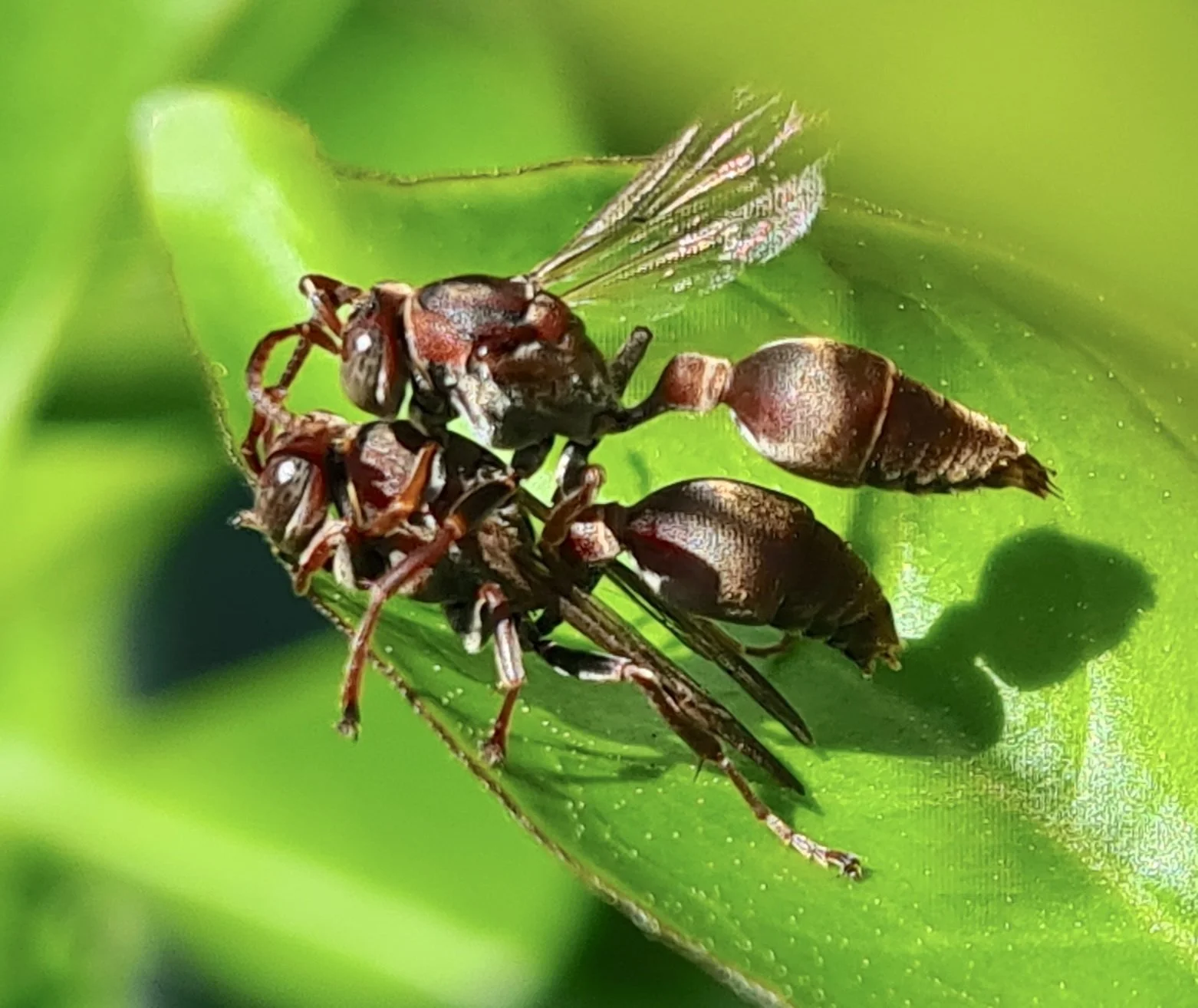
Ropalidia plebeiana
A pair in the throes of coupling … or at least a coupling attempt. It is rare indeed to witness this.
Note that the male genitalia are exserted, clearly visible extending from the tip of the metasoma.
The shape of the metasoma distinguishes this species, as do the serrations on the underside of the male antennae.
Image courtesy of Nells Gross https://inaturalist.ala.org.au/observations/115535536

Ropalidia revolutionalis
Dark ferruginous throughout, more or less mottled black on mesosoma and T2.
Image courtesy of Nick Lambert https://inaturalist.ala.org.au/observations/286531162

Ropalidia plebeiana
Combs suboval or irregular in shape, suspended from one or more central peduncles.
The standout feature of this species, particularly along the south-east coast (Itô & Higashi, 1987), is the aggregation of huge numbers of adjacent combs. Note however, that not all colonies are so large.
Image courtesy of Reiner Richter https://inaturalist.ala.org.au/observations/10447781

Ropalidia plebeiana
Concrete bridges seem particularly attractive to this species, with some well studied colonies in southern NSW known to persist for decades (Itô & Higashi, 1987).
The age of this aggregation on a bridge near Bega in southern NSW is unknown.
Image courtesy of Max Campbell https://inaturalist.ala.org.au/observations/192872817
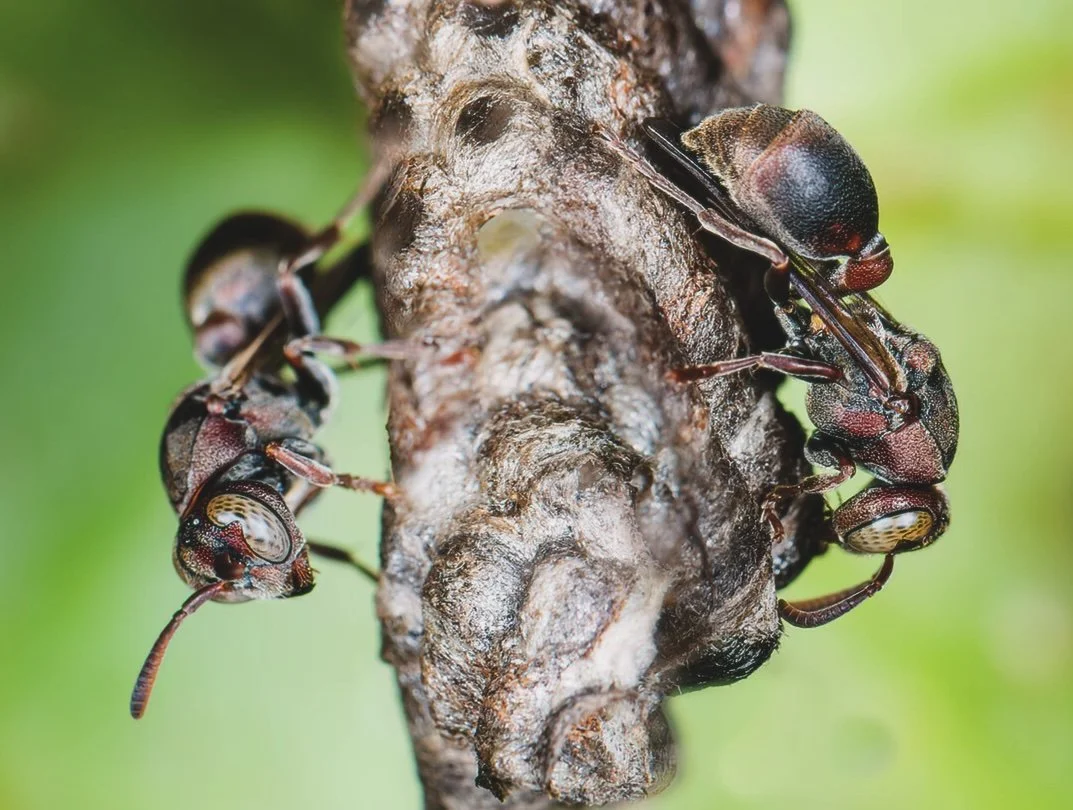
Ropalidia revolutionalis
Dark ferruginous throughout, more or less mottled black on mesosoma and T2.
Head of female dark ferruginous, with blackened areas around antennal sockets and ocelli.
Image courtesy of Norm Farmer https://inaturalist.ala.org.au/observations/257208603

Ropalidia plebeiana
This large nest aggregation was under a rock overhang in the Victoria alps.
Image courtesy of Reiner Richter https://inaturalist.ala.org.au/observations/200893960
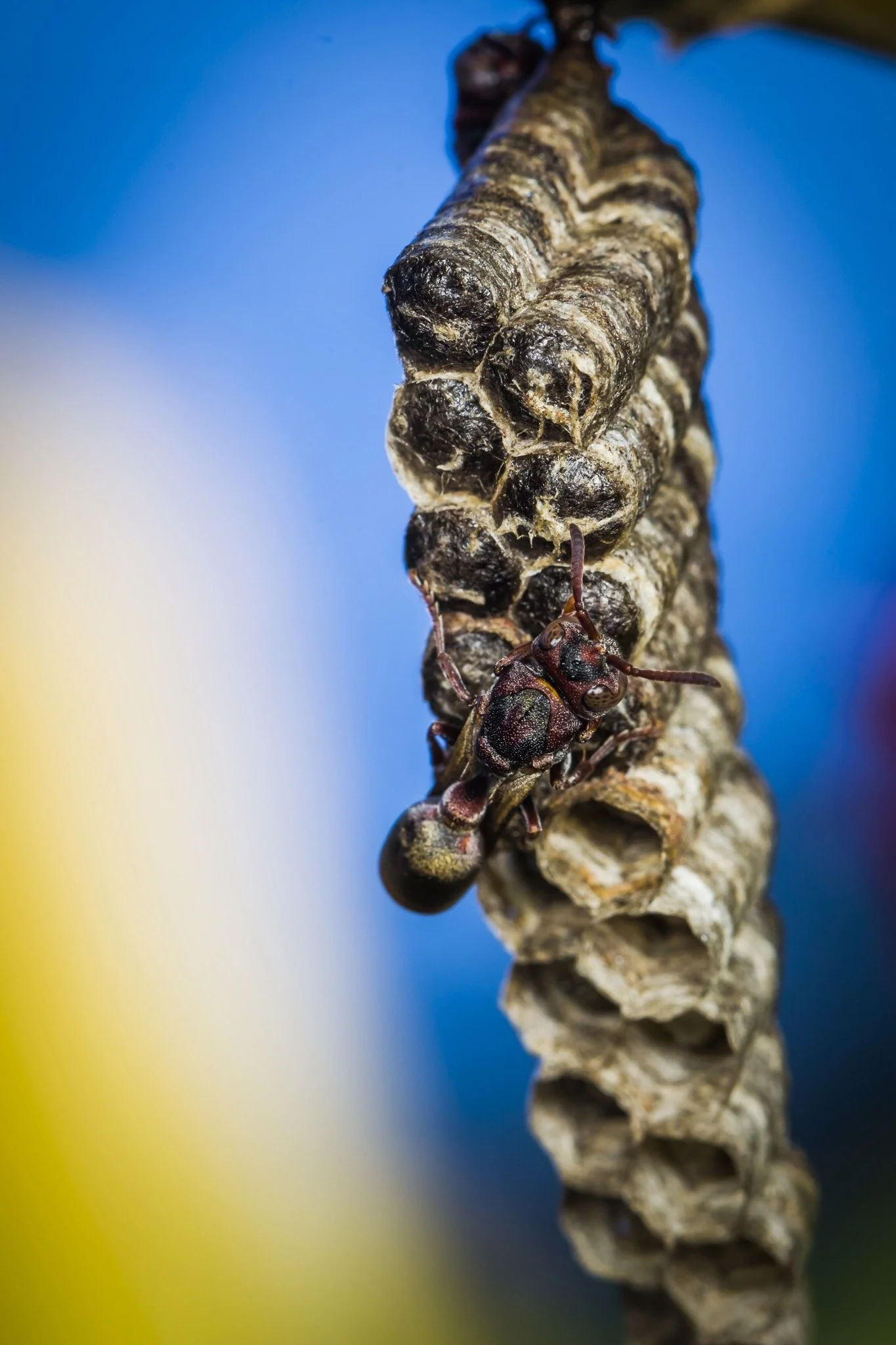
Ropalidia revolutionalis
The combs of this species seem quite stereotypic. Two rows of cells, suspended from a single peduncle at the top, and gradually increasing in length as the season progresses (Hook & Evans, 1982).
Image courtesy of Norm Farmer https://inaturalist.ala.org.au/observations/199621399

Ropalidia revolutionalis
By mid to late summer, it is common for the nest to have expanded to include multiple ‘satellite’ combs (Hook & Evans, 1982).
This image includes several males (green arrows).
Image courtesy of observer ‘jiggy’ https://inaturalist.ala.org.au/observations/260007913

Ropalidia gracilenta
I’ve yet to find any published descriptions of the nest of this species, but this seems representative of the sightings on iNaturalist. Note in particular, the long, oblique cells in a near single column, and the terminal peduncle.
Image courtesy of SG Dickinson https://inaturalist.ala.org.au/observations/107363970
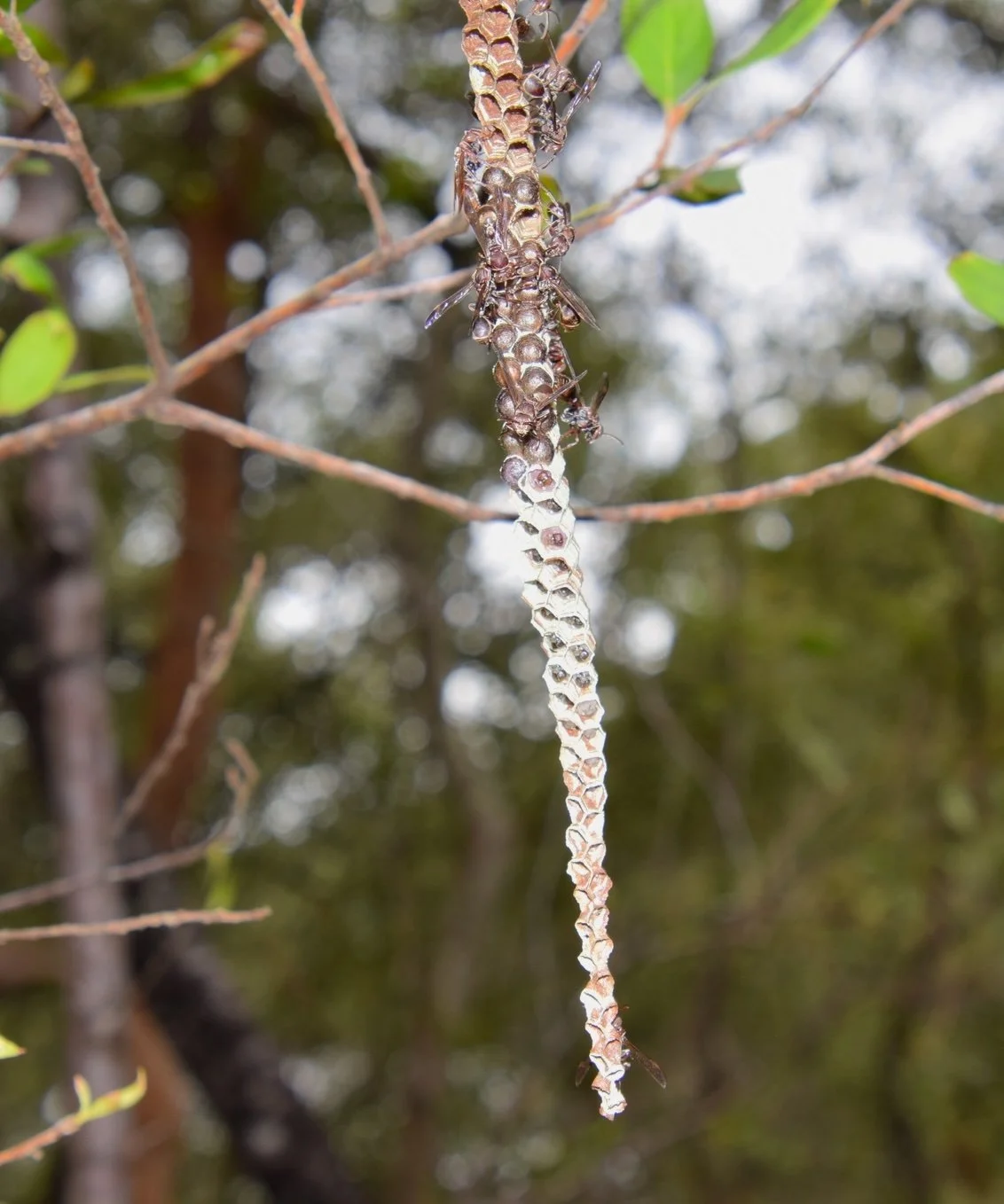
Ropalidia gracilenta
Based on this sighting, combs can be very similar to those made by R. revolutionalis: elongate, 2-cells wide, with a terminal peduncle. There is just a single comb here … in R. revolutionalis, by the time the primary comb is this long, the colony has usually produced additional ‘satellite’ combs. But otherwise I have yet to identify a diagnostic difference.
Take-home message: the comb shape alone should not be relied upon to distinguish R. revolutionalis from R. gracilenta.
Image courtesy of Thomas Mesaglio https://inaturalist.ala.org.au/observations/20362038

Ropalidia impetuosa
Single large comb, leaf-shaped (elongate oval), suspended from vegetation by terminal peduncle.
Image courtesy of Dezmond Wells https://inaturalist.ala.org.au/observations/74372849
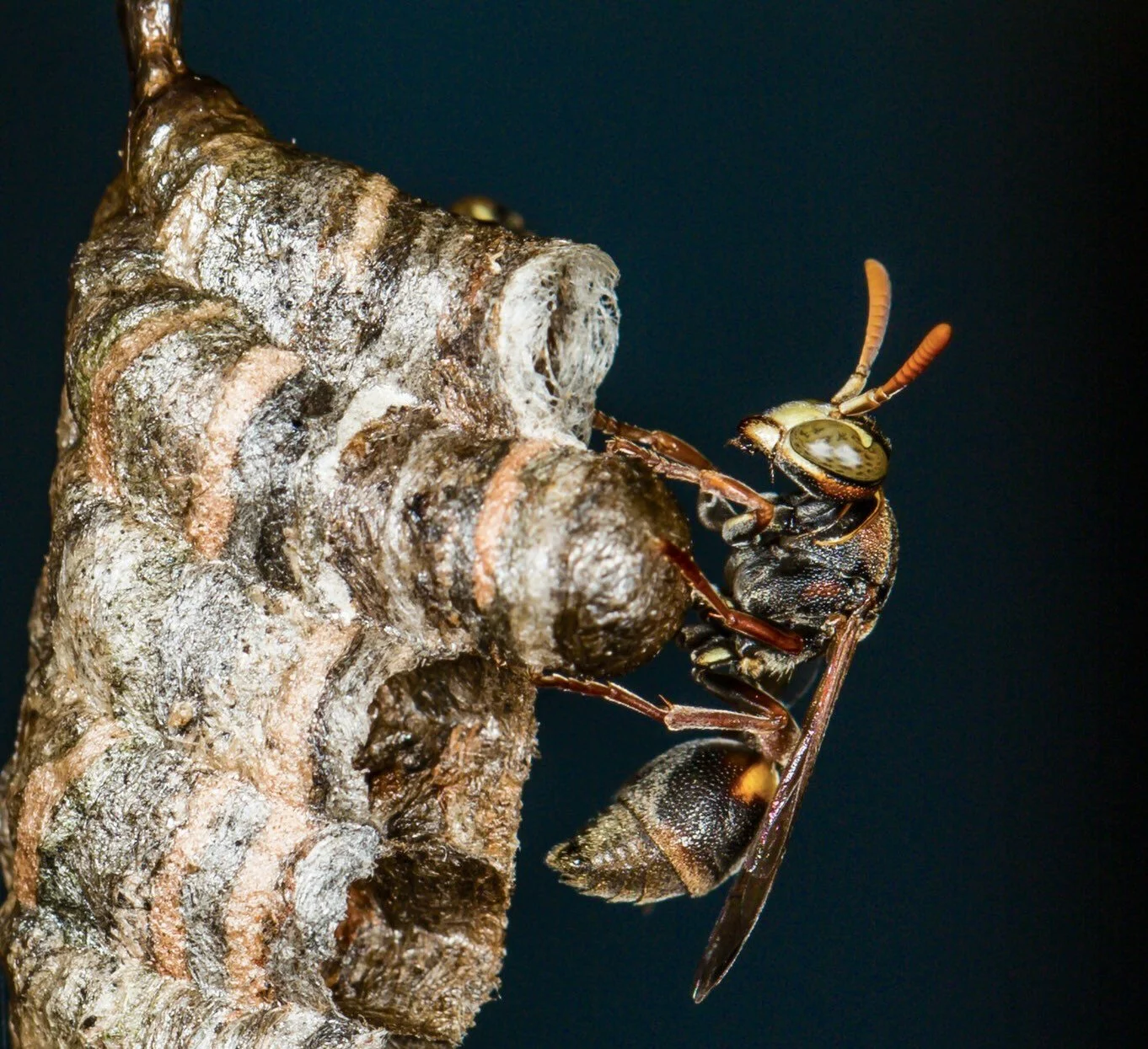
Ropalidia revolutionalis
Males of this species are similarly ferruginous to black.
As here, some have large, pale (or even bright yellow spots) at the base of T2. In either sex, T2 may also have a narrow yellow apical band.
Note too that the male head and face is quite distinctive – almost entirely black above, with extensive yellow markings on the lower face, including the clypeus and most of the mandibles.
Image courtesy of Norm Farmer https://inaturalist.ala.org.au/observations/257208603

Ropalidia revolutionalis
Antennae with 11 flagellar segments (= male).
More extensive yellow head markings than in female of this species.
Image courtesy of Norm Farmer https://inaturalist.ala.org.au/observations/273752872
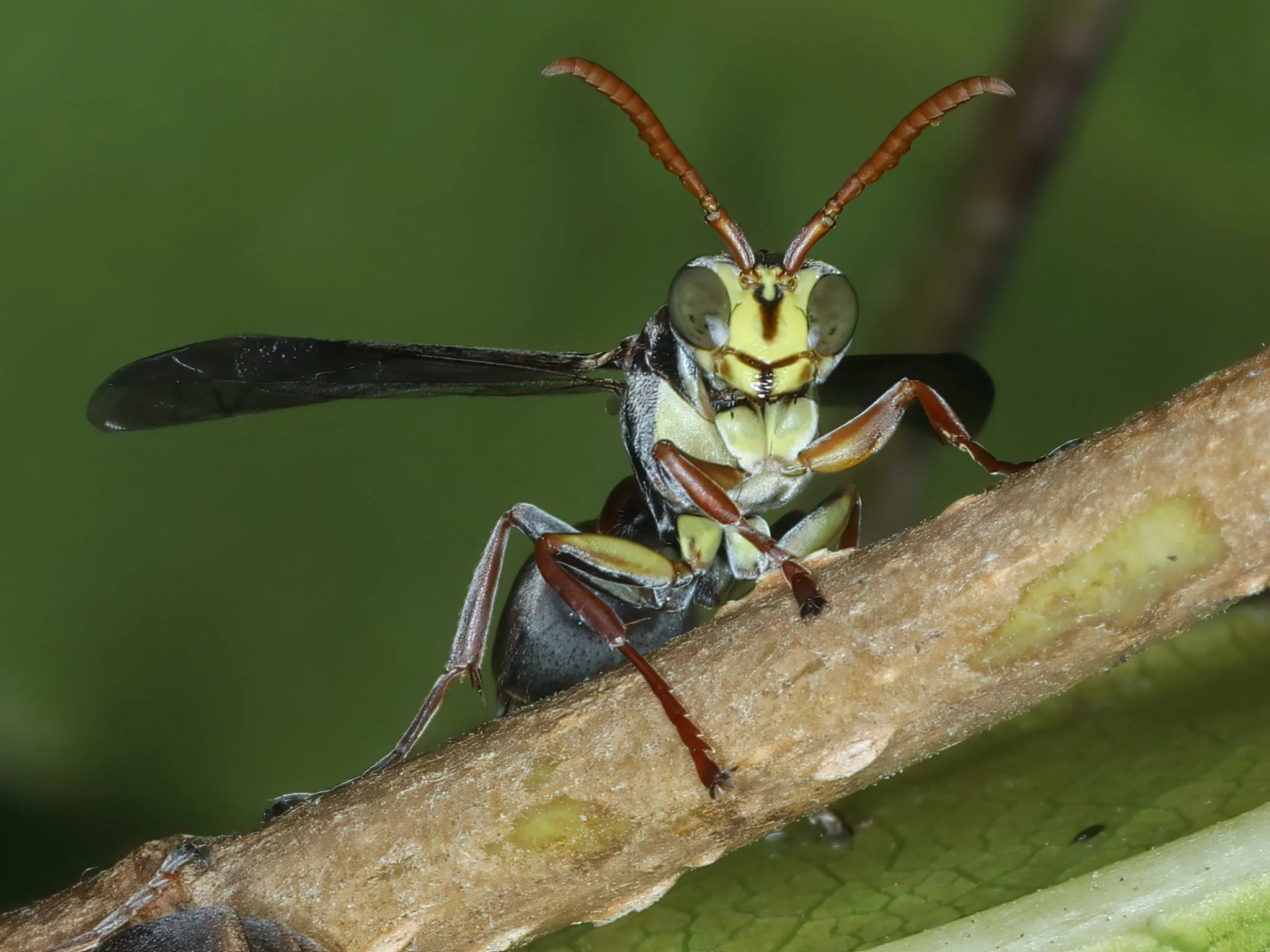
Ropalidia plebeiana
Antennae with 11 flagellar segments (i.e. total of 13 segments, counting the basal scape & pedicel).
Antennae appear serrate (due to the ventral prominences, particularly strong on flagellar segments 2-4). This is a useful diagnostic feature for this species (cf. R. revolutionalis).
Extensive yellow markings on face & clypeus (quite unlike females in this species).
Also extensively yellow on the underside of the mesosoma (‘thorax’), including coxae & anterior side of femora, & mesosternum.
Image courtesy of John Bromilow https://inaturalist.ala.org.au/observations/109356751

Ropalidia plebeiana
7 visible metasomal tergites (= male)
https://inaturalist.ala.org.au/observations/78038563

Ropalidia socialistica
Large, naked (i.e. without paper covering), vertical comb, typically in a tree crevice … as here.
Image courtesy of Reiner Richter https://inaturalist.ala.org.au/observations/53566113

Ropalidia plebeiana
Antennae with 11 flagellar segments (= male).
Male antennae modified in this species, appearing serrate due to ventral projections, and with hooked terminal segment.
https://inaturalist.ala.org.au/observations/78038563

Ropalidia romandi
Massive nests, sometimes home to thousands of wasps. Inside the papery envelope are a large number of free-hanging combs. The nests are typically suspended among tree branches.
Image courtesy of Jemaine Mulcahy https://inaturalist.ala.org.au/observations/241384764

Polistes stigma townsvillensis
T1 black basally, with yellow sides and apical band (variable).
T2 and T3 with apical yellow bands. This too is highly variable, and T2 usually lacks a band).
Mesoscutum here black (more typically ferruginous).
Costal region of wings brown, the marginal cell with a dark spot. Veins brown.
https://inaturalist.ala.org.au/observations/145398758

Polistes humilis
A particularly ferruginous colour variant of this species.
A complete absence of yellow bands on the gaster (a common state for P. humilis).
Note the black mesopleura, with a reddish spot (cf P. schach).
Note too the darkly fuscous wings, lacking any distinct black spot in the region of the marginal cell.
Image courtesy of Harvey Perkins https://inaturalist.ala.org.au/observations/263367081

Polistes humilis
Black with extensive ferruginous markings.
Mesoscutum extensively black.
Mesopleuron black, with anterodorsal reddish spot.
Mesosternum yellow.
Mandibles yellow. Also yellow markings in malar space, and a stripe along the gena.
Forewings strongly fuscous.
Image courtesy of Nick Lambert https://inaturalist.ala.org.au/observations/265382858

Polistes humilis
Extensive yellow markings are common among P. humilis synoecus, including often complete-length yellow stripes on the propodeum (as here). This subspecies often has several yellow bands on the gaster, and a band on T2 is not unusual.
Image courtesy of Nadine Gaffney https://inaturalist.ala.org.au/observations/296708279

Polistes humilis
Clypeus yellow, with ferruginous dorsal marks and black margin.
Frons ferruginous, with yellow along inner orbits.
Mandibles ferruginous.
Mesosternum black in this female (cf yellow in males).
Image courtesy of John Tann https://inaturalist.ala.org.au/observations/302547121

Polistes humilis
Male with extensive yellow markings on head, including: clypeus; mandibles; inner orbits to bottom of ocular sinus (notch in eye); interantennal spacescape beneath; malar space (varies).
Mesosternum also extensively yellow in male, along with coxae, and stripes along the femora.
Image courtesy of John Tann https://inaturalist.ala.org.au/observations/302547121

Polistes chinensis ('Asian Paper Wasp')
Native to the Palaearctic region. Introduced into the Sydney area, & established by 2008. Also introduced in New Zealand. Now widespread and (disturbingly) common throughout south-eastern NSW and Victoria.
Nests are the typical, dangling umbrella-shaped comb, often built under outdoor structures or in vegetation.
Image courtesy of Reiner Richter https://inaturalist.ala.org.au/observations/191344848

Polistes dominula ('European Paper Wasp')
Native to the Palaearctic Region. Introduced into the Perth area and established by 1977. Now apparently also established around Melbourne and central Victoria.
Very similar to P. chinensis, but with a pair of yellow marks on the mesoscutum.
The nests can become quite large, and are sometimes built in secluded locations such as roof cavities.
Image courtesy of John Cull https://inaturalist.ala.org.au/observations/203855668

For reference: the various regions, ridges and grooves of the mesopleura in Polistes.
In particular, note the location of the epicnemial carina and the dorsal groove. There presence or absence is a key to the subfamilies.
Note too the location of the mesepimeron and mesepisternum, and that together these form the mesopleuron. The colour pattern of the mesopleuron can help distinguish between species, particularly between P. humilis and P. stigma.
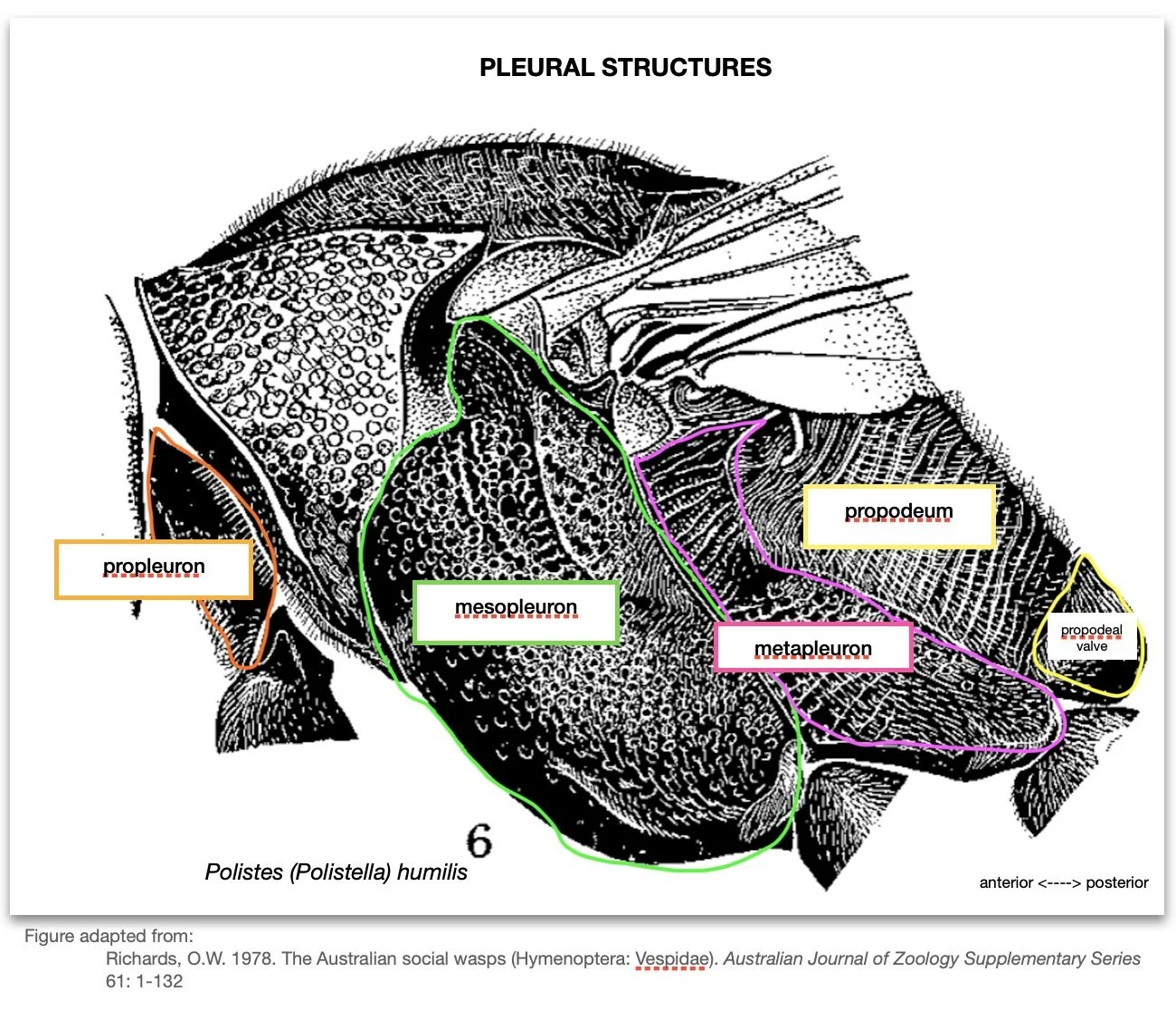
For reference: the location and extent of each of the major lateral structures of Polistes.
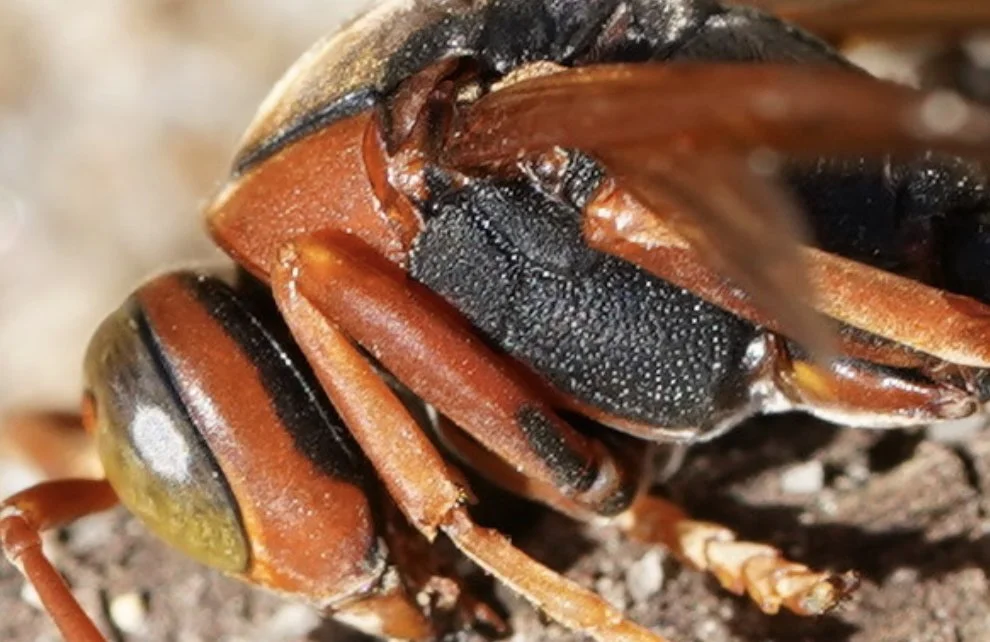
Mesoepisternum with dorsal groove and epicnemial carina = subgenus Gyrostoma.
Image courtesy of Reiner Richter https://inaturalist.ala.org.au/observations/20361200
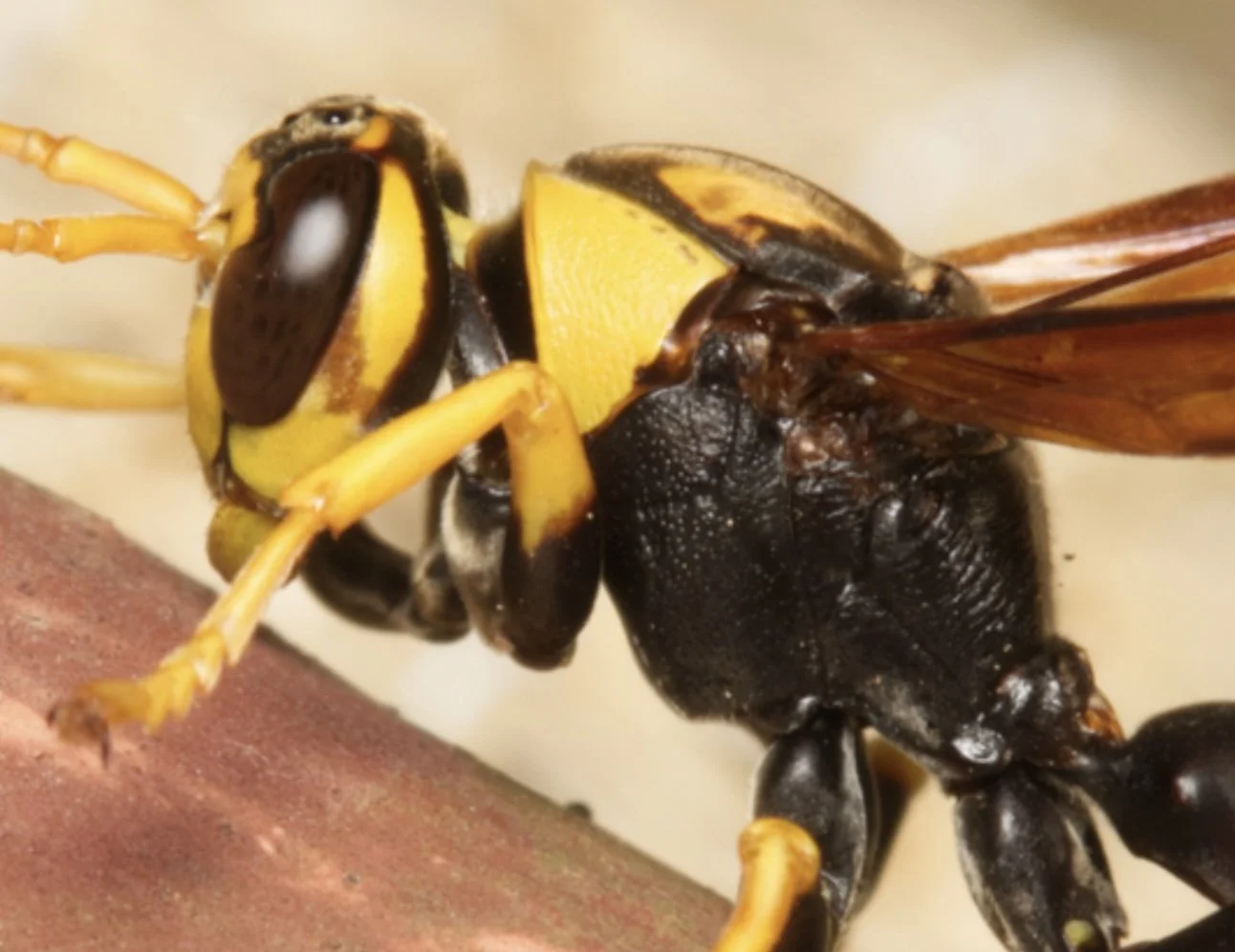
Dorsal groove and epicnemial carina of mesepisternum evident = subgenus Gyrostoma.
Mesopleuron entirely black = typical of Polistes tepidus.
Image courtesy of Nigel Main https://inaturalist.ala.org.au/observations/149521599
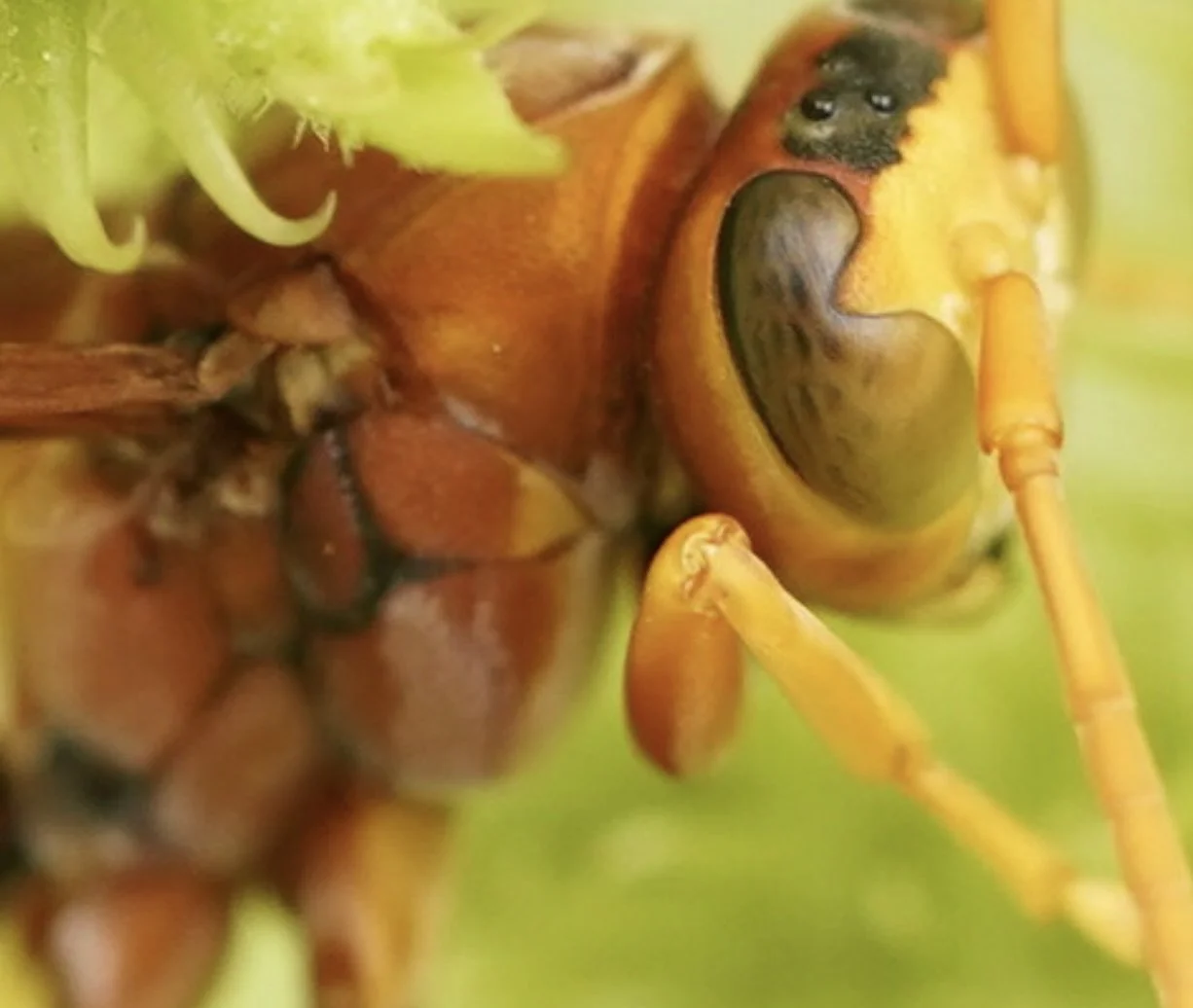
Dorsal groove of mesepimeron made obvious here due to black markings in the sutures = subgenus Gyrostoma.
Mesopleuron orange, with black lining of sutures = Polistes schach.
Note also the small yellow patch in the anterodorsal region of the mesepisternum.
Large yellow patch on anterior mesosternum = typical of male P. schach.
Image courtesy of Reiner Richter
https://inaturalist.ala.org.au/observations/154552500

In this high resolution image, the scrobal sulcus is obvious … and is is equally clear that there is no dorsal groove = subgenus Polistella.
This very orange variant of P. humilis is otherwise easily mistaken for P. schach.
Image courtesy of Gunter Maywald
https://inaturalist.ala.org.au/observations/156358837
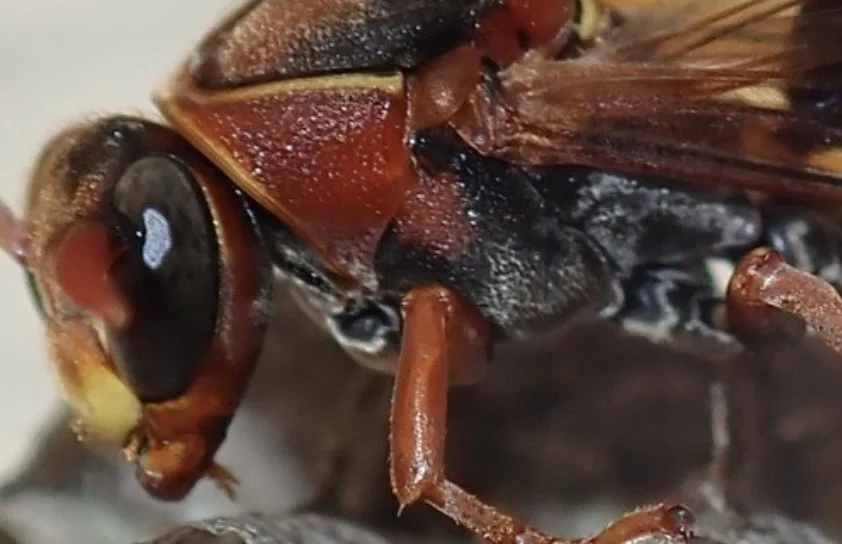
No apparent grooves or carina on mesepisternum (although difficult to be sure), suggesting subgenus Polistella.
Mesepisternum black, with large anterodorsal reddish spot = common pattern for P. humilis.
Image courtesy of Thomas Mesaglio https://inaturalist.ala.org.au/observations/35482110
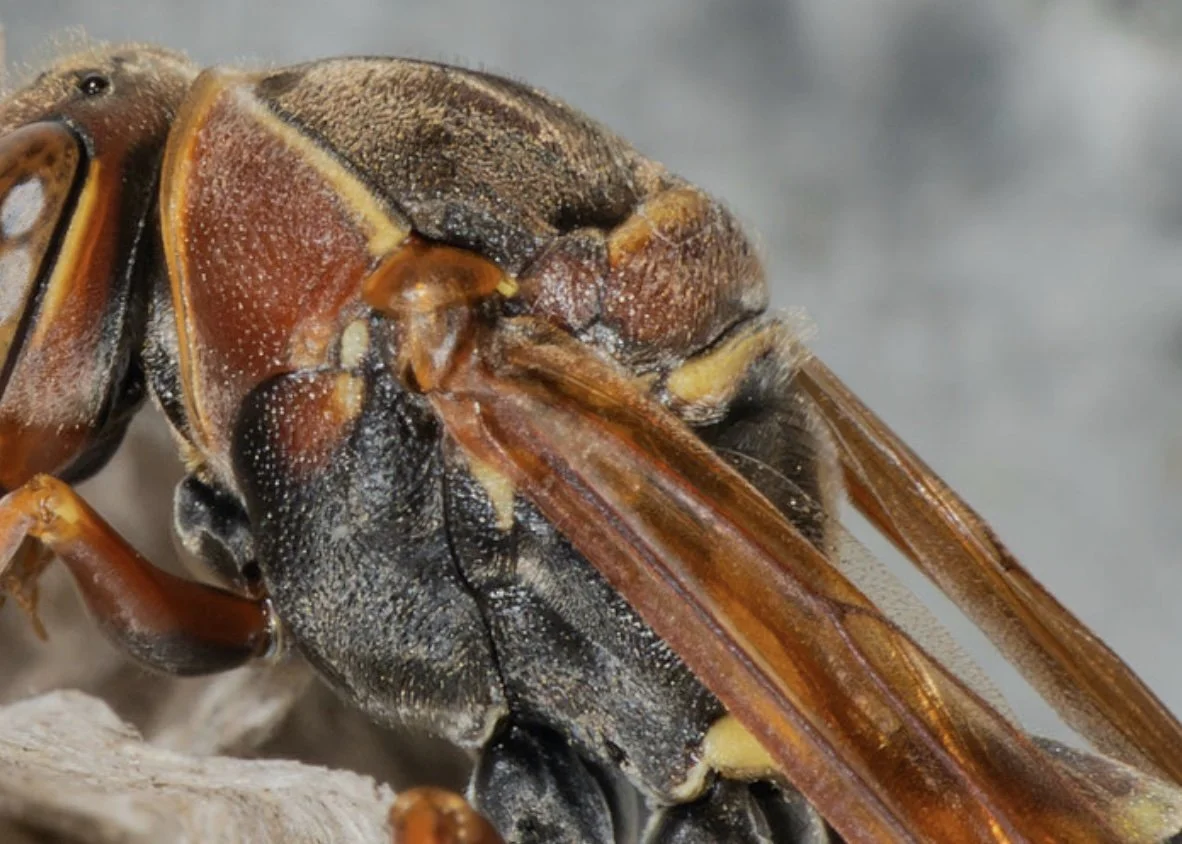
No dorsal groove on mesepisternum = subgenus Polistella.
(Note that from this angle it isn’t possible to assess the presence/absence of the epicnemial carina.)
Mesopleuron black, with a red & yellow mark in the anterodorsal region of the mesepisternum = consistent with P. humilis, and suggestive of the subspecies P. humilis synoecus.
Image courtesy of Nadine Gaffney https://inaturalist.ala.org.au/observations/263477744
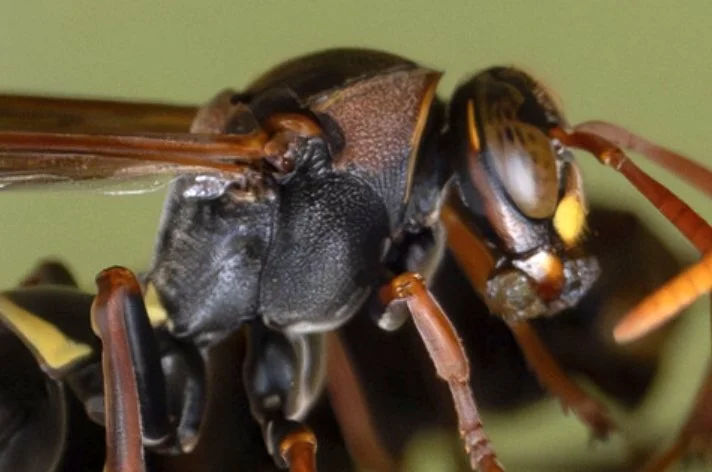
Mesepisternum without dorsal groove or epicnemial carina = subgenus Polistella.
Mesepisternum entirely black = typical base colour for P. humilis.

No dorsal groove or epicnemial carina on mesopleuron = subgenus Polistella.
Mesopleuron ferruginous, with large black spot on mesepimeron = Polistes stigma townsvillensis.
Image courtesy of Norm Farmer
https://inaturalist.ala.org.au/observations/265035366

Comparison of head shape for the five candidate species of Polistes, with an emphasis on differences between subgenera.
The eyes of Polistella species are relatively large, extending beyond the midpoint of the clypeus. The malar space is therefore considerably shorter than in Gyrostoma.
In addition, when viewed from this angle, the head appears more triangular in Polistella.
… I think of Gyrostoma as having ‘chubby cheeks’.
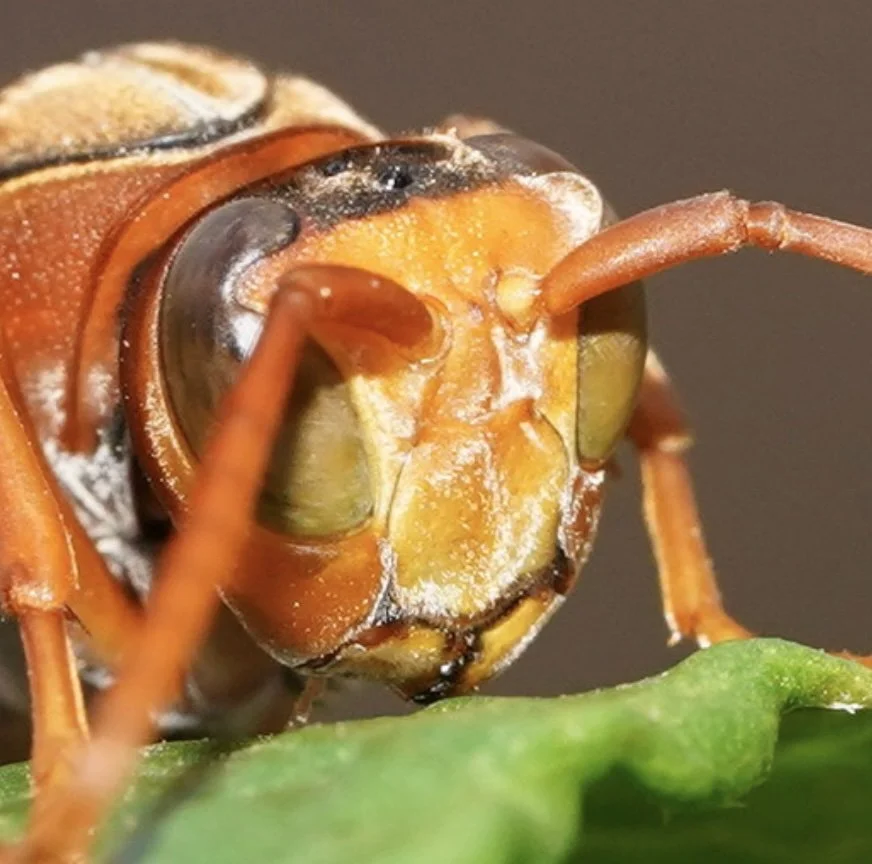
Malar space relatively long, eye not reaching midpoint of clypeus = subgenus Gyrostoma.
Note also, the eye is distinctly separated from the clypeus = a feature of P. erythrinus.
Image courtesy of Reiner Richter https://inaturalist.ala.org.au/observations/21292500

Genae relatively wide, giving the distinctive ‘chubby cheeks’ appearance of this subgenus (Gyrostoma).
Image courtesy of Reiner Richter
https://inaturalist.ala.org.au/observations/154552500
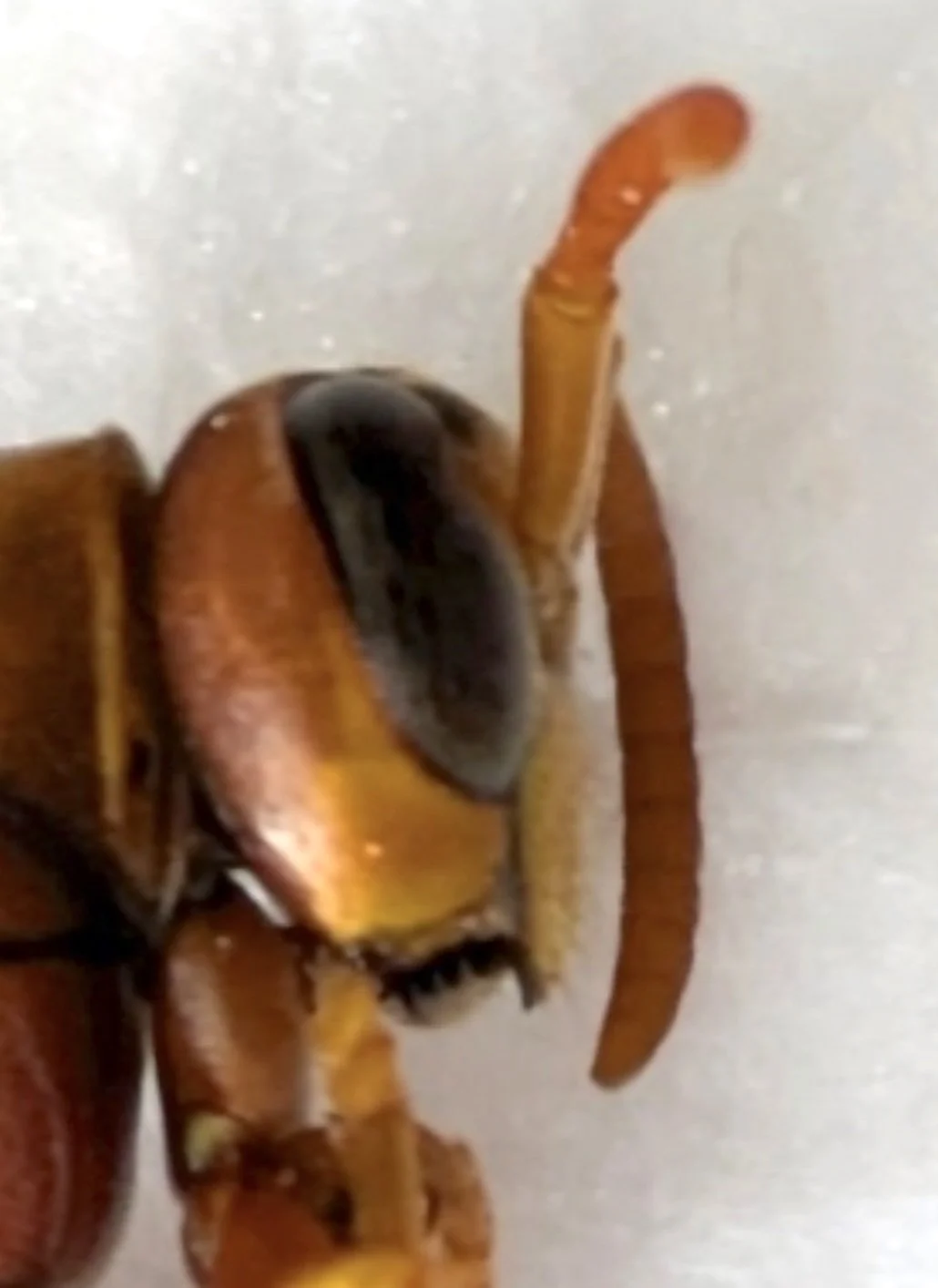
The eye does not reach the midpoint of the clypeus, and the genae are relatively wide = subgenus Gyrostoma.
Image courtesy of Kent Walker https://inaturalist.ala.org.au/observations/253254052
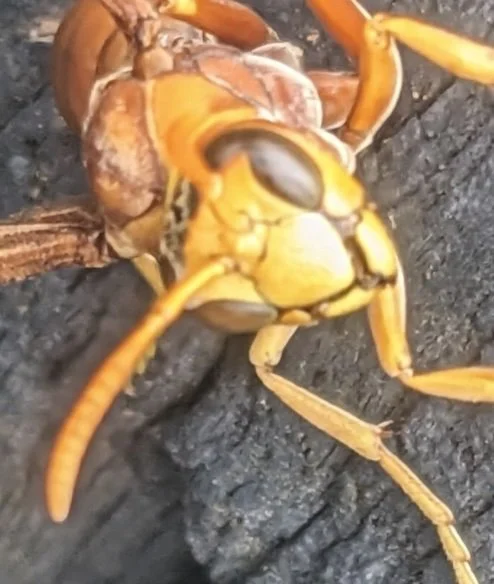
Malar space relatively long, eye not extending to midpoint of clypeus = subgenus Gyrostoma.
Note that the eye is not separated from the clypeus (unlike in P. erythrinus).
Note too the almost triangular shape of the clypeus = a feature of P. schach females.
Image courtesy of Richard Shirky https://inaturalist.ala.org.au/observations/192855939
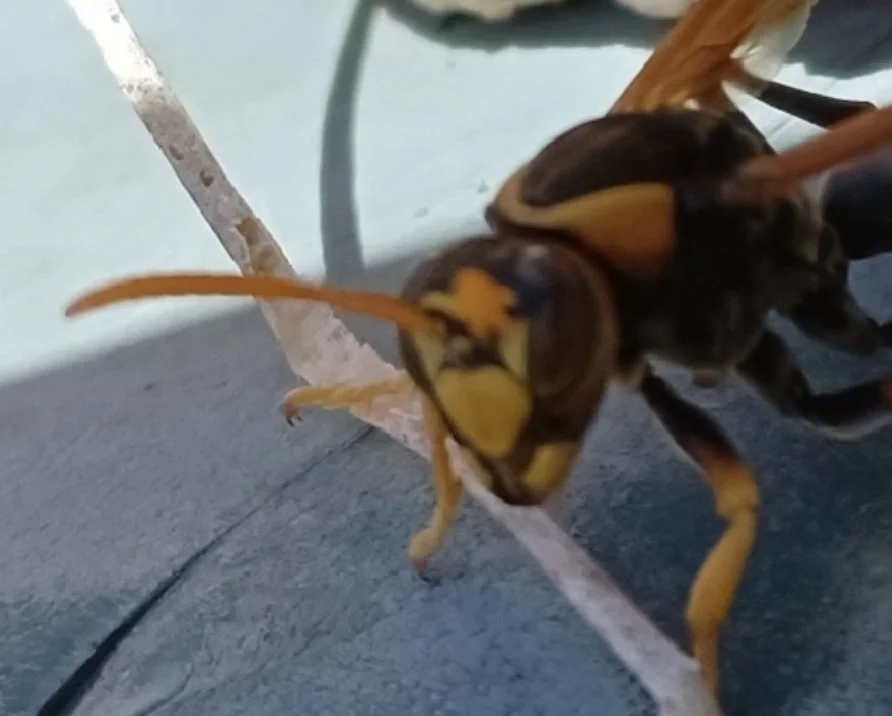
Bottom of eye is well above the midpoint of the clypeus = subgenus Gyrostoma.
Image courtesy of Nells Gross
https://inaturalist.ala.org.au/observations/190482787
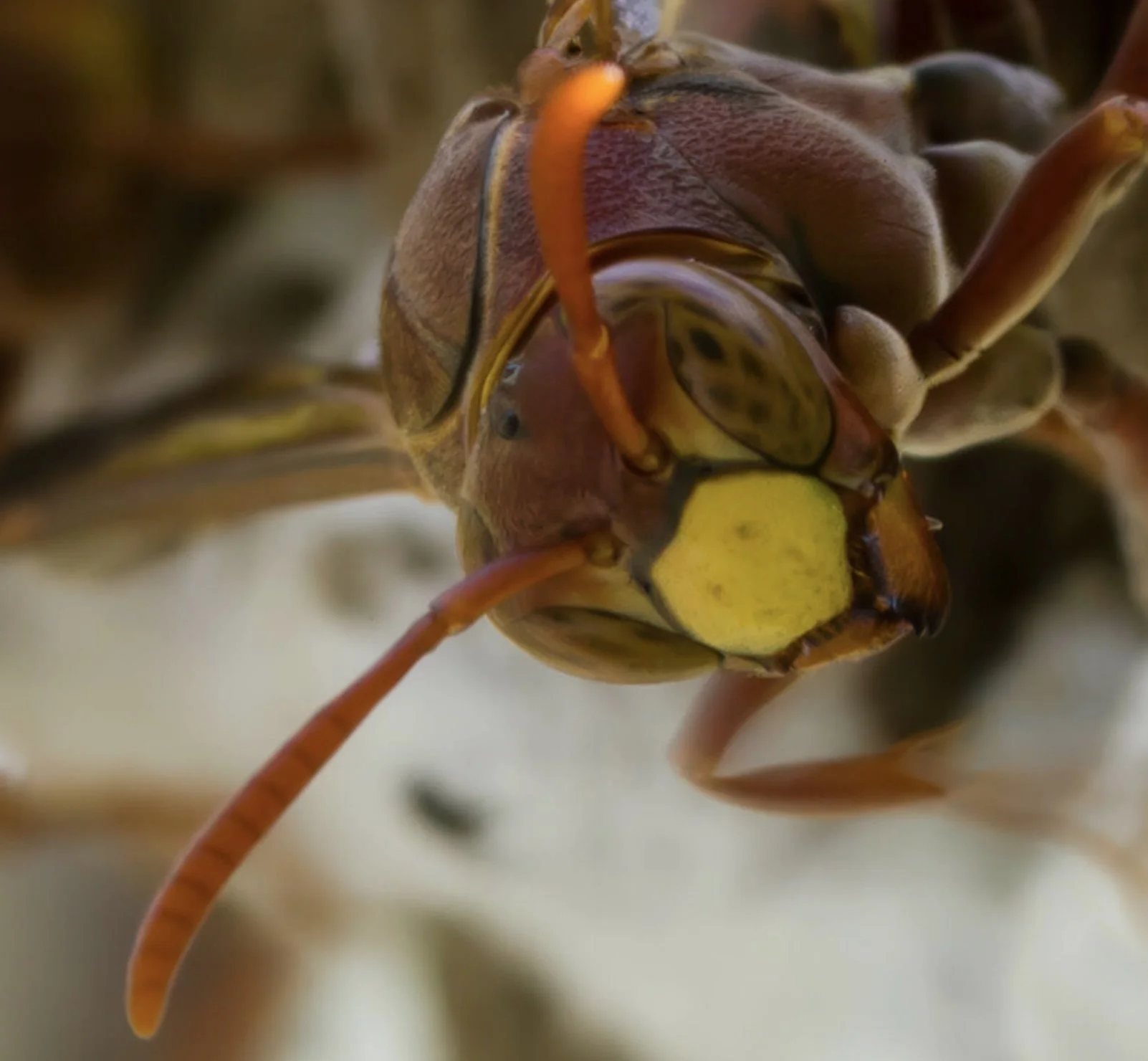
Eye extends beyond midpoint of clypeus = subgenus Polistella.
Image courtesy of Norm Farmer https://inaturalist.ala.org.au/observations/265035209
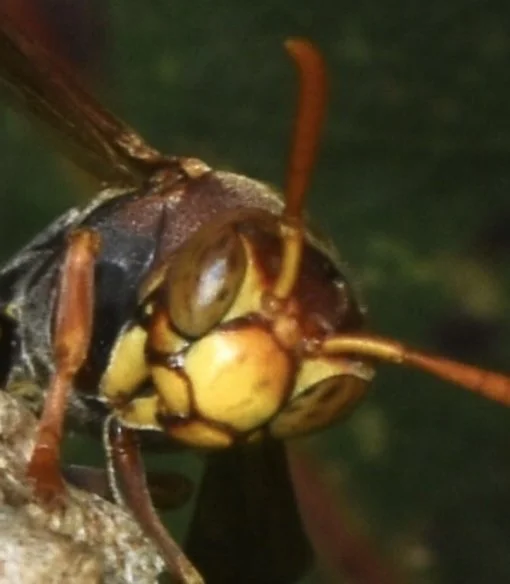
Eye extends well beyond midpoint of clypeus, and head quite strongly triangular = subgenus Polistella.
Image courtesy of Nicholas John Fisher https://inaturalist.ala.org.au/observations/315413841
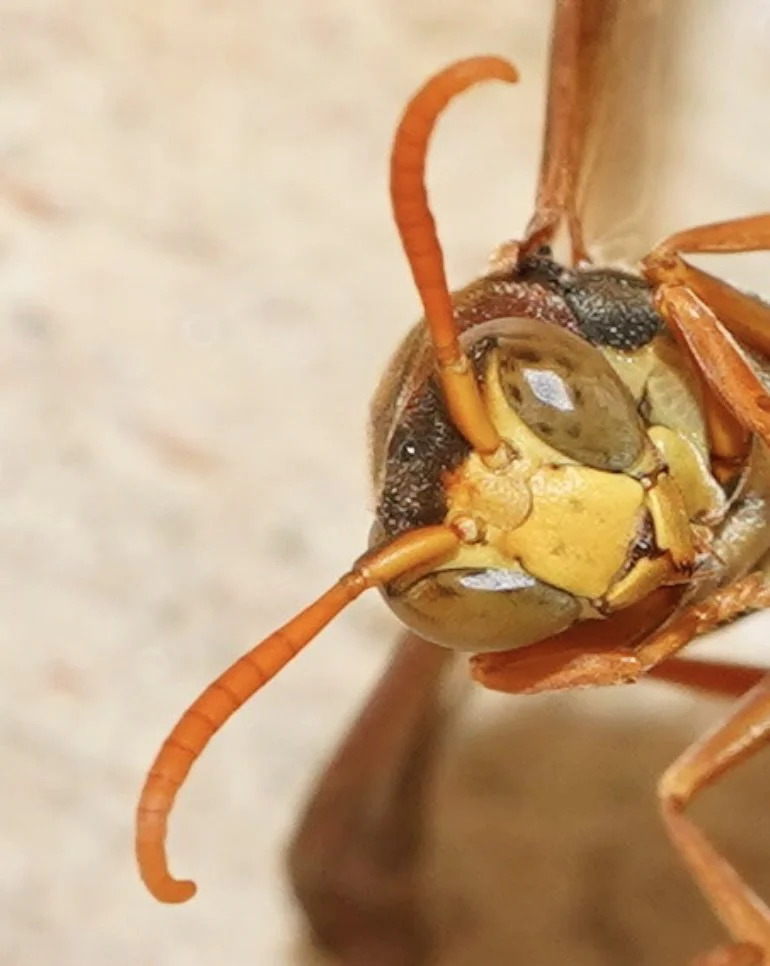
Very short malar space, eyes extending beyond midpoint of clypeus, head triangular from this perspective = subgenus Polistella.
Note that the triangular shape of the head is even more pronounced in males of this species than it is in females.
Image courtesy of Reiner Richter https://inaturalist.ala.org.au/observations/21440246
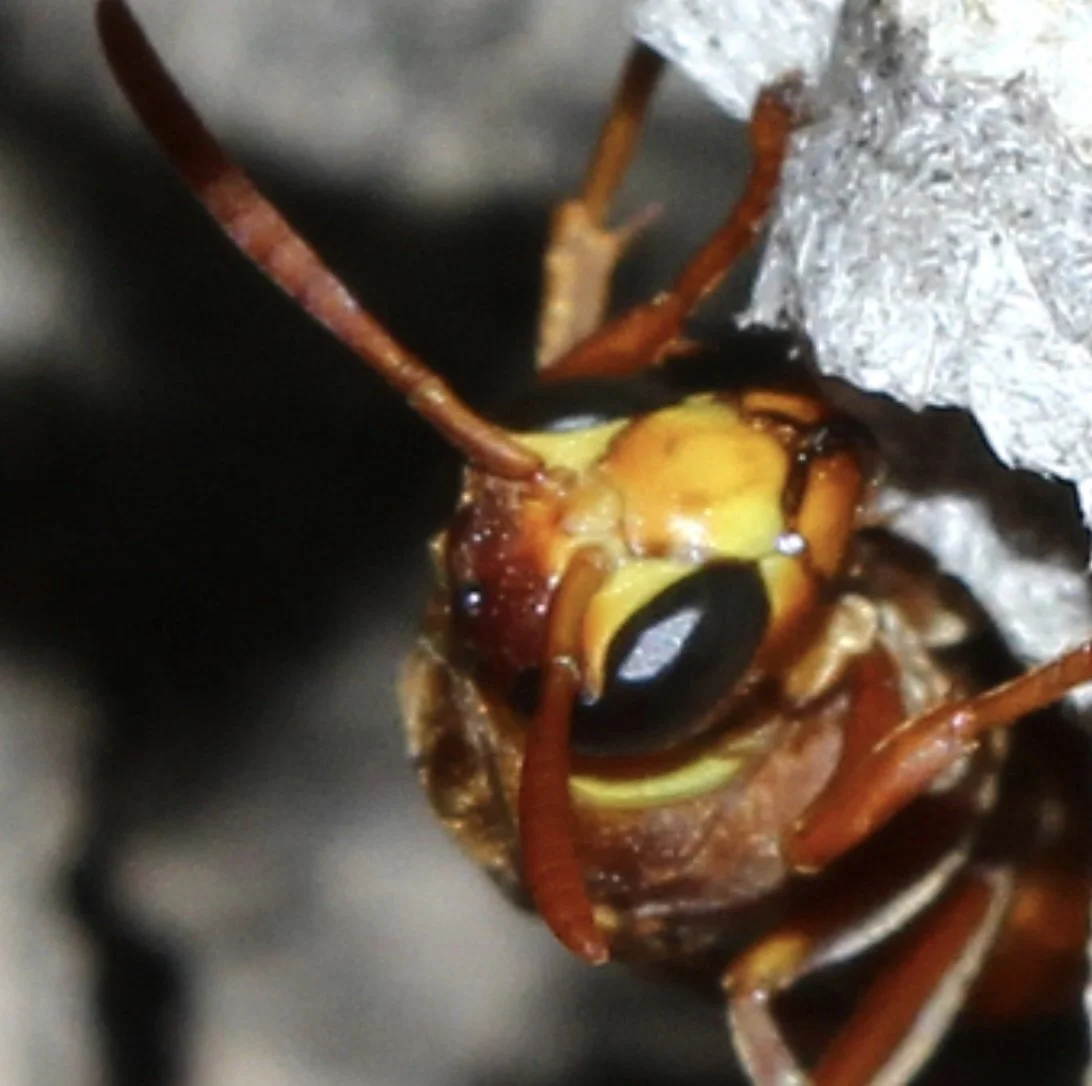
Eye extends beyond midpoint of clypeus = subgenus Polistella.
Image courtesy of Lachlan Copeland https://inaturalist.ala.org.au/observations/199046035
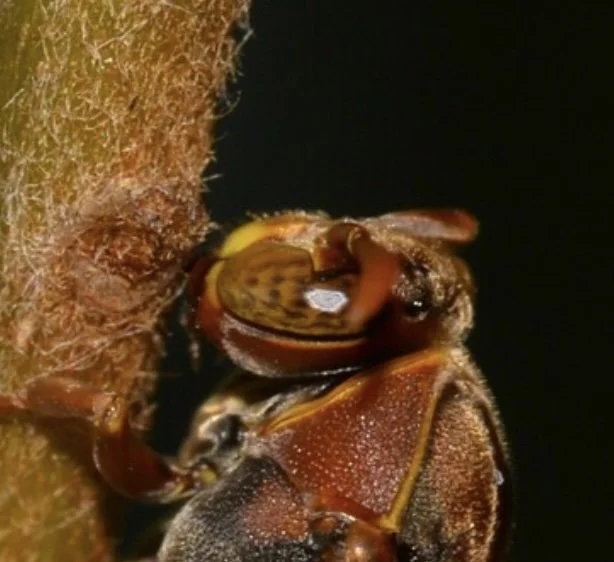
From this angle it’s difficult to make a call on the eye-clypeus relationship. However, the narrow genae and vertex point are consistent with subgenus Polistella.
Image courtesy of Nick Lambert https://inaturalist.ala.org.au/observations/237447653
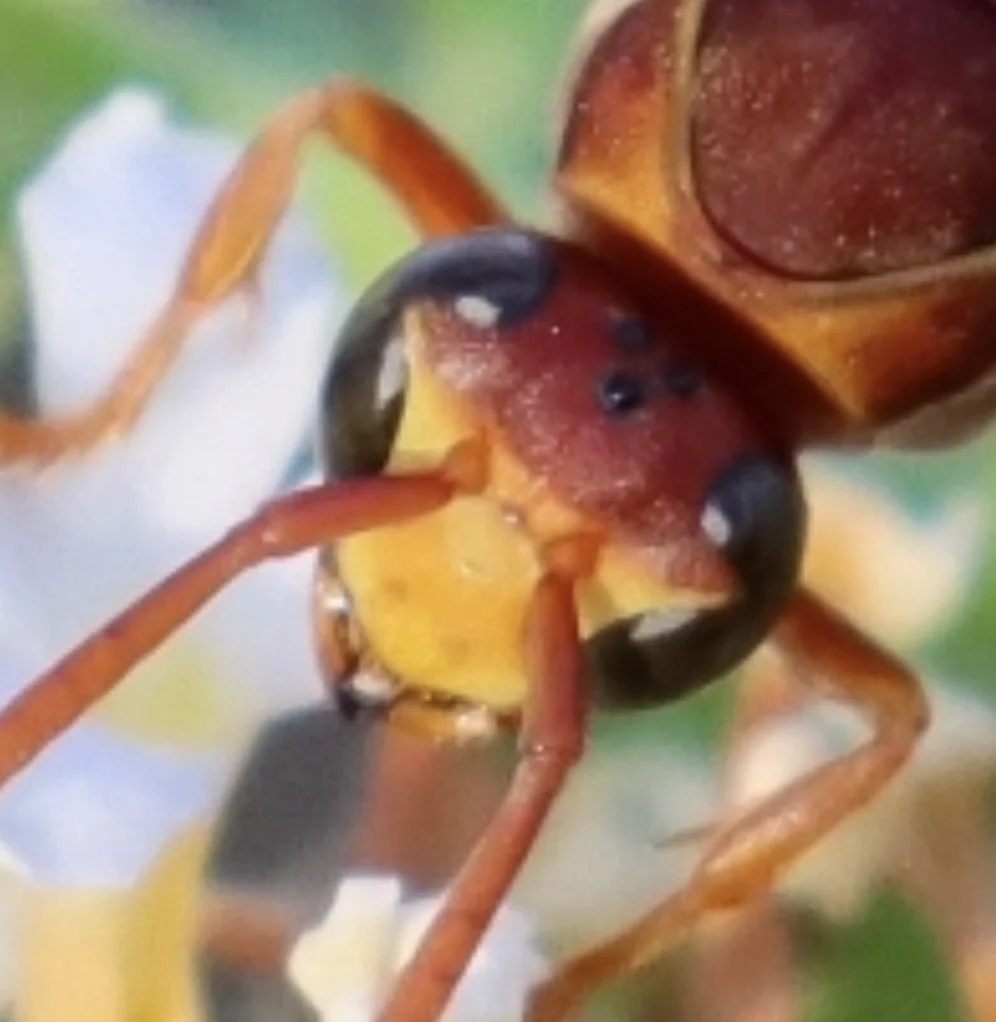
The head is quite triangular, relatively wide across the top and narrowing below = subgenus Polistella.
Image courtesy of Jessy Cottee https://inaturalist.ala.org.au/observations/256864592

Several males ‘standing tall’, displaying their colourful underparts.
Image courtesy basicz https://inaturalist.ala.org.au/observations/275628280
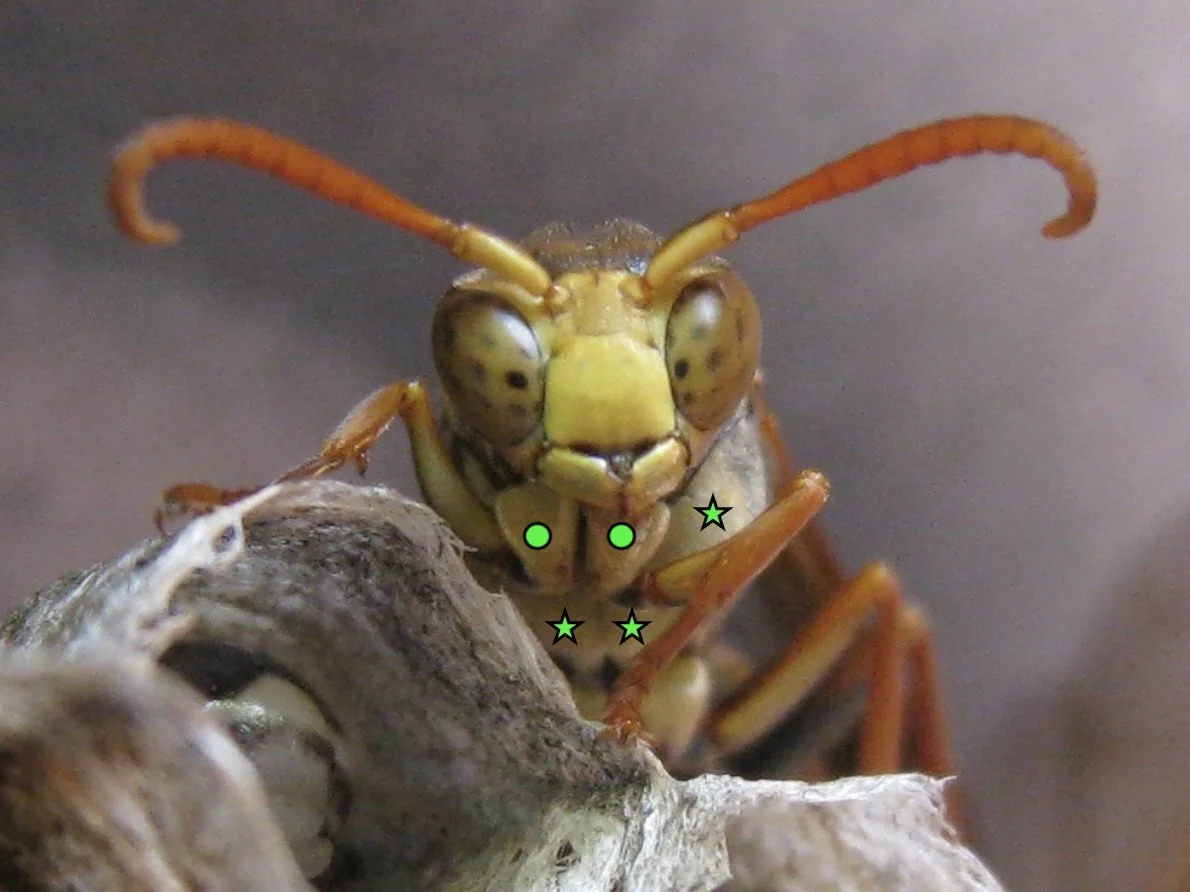
The mesosternum* (stars) is extensively yellow, as are the front coxae (circles).
[*technically the region referred to as the mesosternum is the ventral part of the mesepisternum … but for simplicity I have followed the terminology of Richards 1978]
Image courtesy of John Tann https://inaturalist.ala.org.au/observations/302547121

Yellow mesosternum (arrow) visible in the male, behind the front coxae which are also fully yellow.
Image courtesy of Locky Cooper https://inaturalist.ala.org.au/observations/154067286

One of the features separating P. humilis from P. stigmatownsvillensis in Richards’ (1978) key to the adults of Australian species of Polistes is the shape of the first gastral segment.
The distinction is relatively subtle, but in full lateral view the ratios of length to height are measurably different.

Polistes humilis humilis
The shape of the first gastral segment is a clear match for P. humilis: relatively short and steeply rising.
Image courtesy of Reiner Richter https://inaturalist.ala.org.au/observations/255321869

Polistes humilis synoecus
Due to the relatively steep slope of T1, it can appear particularly short when viewed dorsally.
Note that the yellow markings on T1 and on the propodeum are similar to those of P. stigma.
Image courtesy of Nadine Gaffney https://inaturalist.ala.org.au/observations/289477883
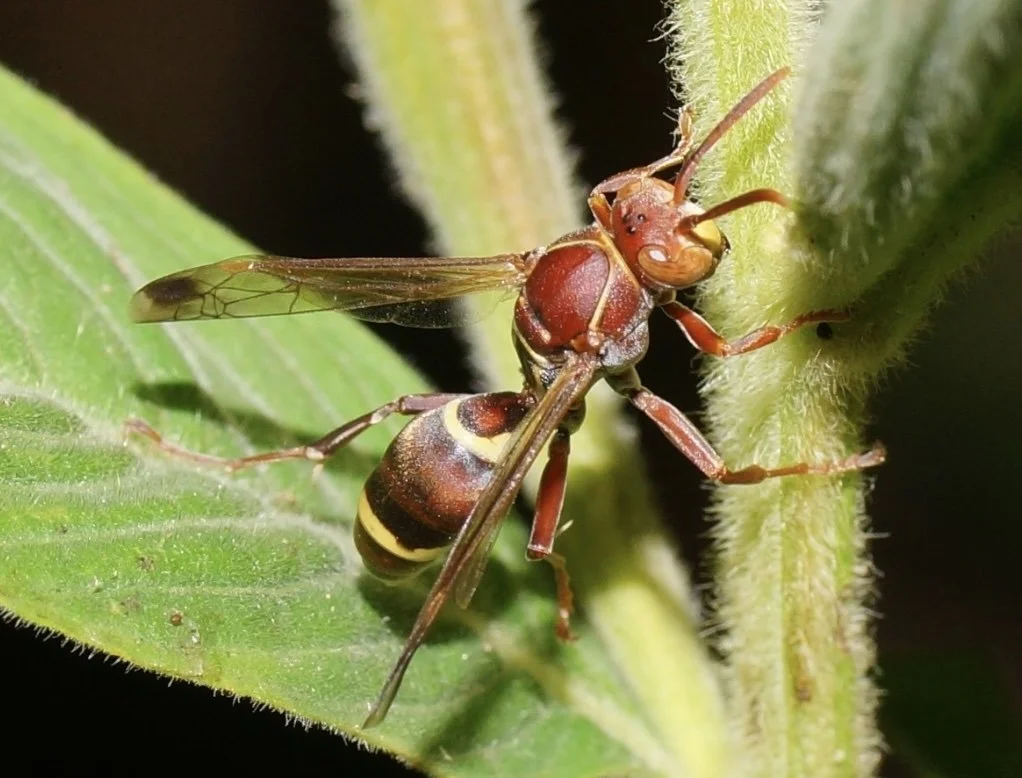
Polistes stigma townsvillensis
Perhaps there is a suggestion of a more gradual rise in T1 here, but from such an angle it is difficult to call.
Note the clearly defined dark wing spot in this image, a distinguising feature of this species (cf. P. humilis).
Image courtesy of Reiner Richter https://inaturalist.ala.org.au/observations/16575782
(Far North QLD)













































































